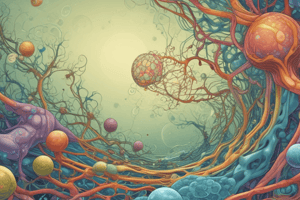Podcast
Questions and Answers
Which organelle is responsible for breaking down waste and foreign substances in the cell?
Which organelle is responsible for breaking down waste and foreign substances in the cell?
- Lysosomes (correct)
- Endoplasmic Reticulum
- Mitochondria
- Ribosomes
What is the primary function of the phospholipid bilayer in the cell membrane?
What is the primary function of the phospholipid bilayer in the cell membrane?
- To generate energy for the cell
- To store genetic material
- To regulate the movement of molecules in and out of the cell (correct)
- To synthesize proteins
What is the primary function of the plasma membrane?
What is the primary function of the plasma membrane?
- To synthesize proteins
- To store genetic material
- To generate energy for the cell
- To control the movement of molecules in and out of the cell (correct)
What type of diffusion requires the use of energy?
What type of diffusion requires the use of energy?
What is the approximate percentage of water in living organisms?
What is the approximate percentage of water in living organisms?
What is the function of the endoplasmic reticulum (ER) in the cell?
What is the function of the endoplasmic reticulum (ER) in the cell?
What is the site of protein synthesis in the cell?
What is the site of protein synthesis in the cell?
What is the function of the mitochondria in the cell?
What is the function of the mitochondria in the cell?
What is the term for the movement of molecules from an area of higher concentration to an area of lower concentration?
What is the term for the movement of molecules from an area of higher concentration to an area of lower concentration?
What are the basic structural and functional units of life?
What are the basic structural and functional units of life?
Flashcards are hidden until you start studying
Study Notes
Cell Structure and Function
Cell Membrane
- A thin, semi-permeable membrane that surrounds the cell
- Composed of phospholipid bilayer with embedded proteins
- Regulates what enters and leaves the cell
- Maintains cell shape and provides mechanical support
Cell Organelles
- Specialized structures within the cell that perform specific functions
- Examples:
- Nucleus: contains genetic material (DNA)
- Mitochondria: generates energy for the cell
- Endoplasmic Reticulum (ER): involved in protein synthesis and transport
- Ribosomes: site of protein synthesis
- Lysosomes: contain digestive enzymes for breaking down waste and foreign substances
Function of Plasma Membrane
- Controls the movement of molecules in and out of the cell
- Regulates the exchange of nutrients, waste, and signaling molecules
- Maintains cell homeostasis and osmotic balance
Diffusion in Cells
- The movement of molecules from an area of higher concentration to an area of lower concentration
- Types of diffusion:
- Passive diffusion: movement down concentration gradient (e.g., diffusion of oxygen into the cell)
- Facilitated diffusion: movement down concentration gradient using transport proteins (e.g., glucose uptake)
- Active transport: movement against concentration gradient using energy (e.g., pumping ions out of the cell)
Composition of Living Organisms
- Living organisms are composed of cells, which are the basic structural and functional units of life
- Cells are made up of:
- Water (~70%)
- Organic compounds (carbohydrates, proteins, fats, nucleic acids)
- Inorganic compounds (salts, minerals)
- Organelles and other cellular structures
Studying That Suits You
Use AI to generate personalized quizzes and flashcards to suit your learning preferences.




